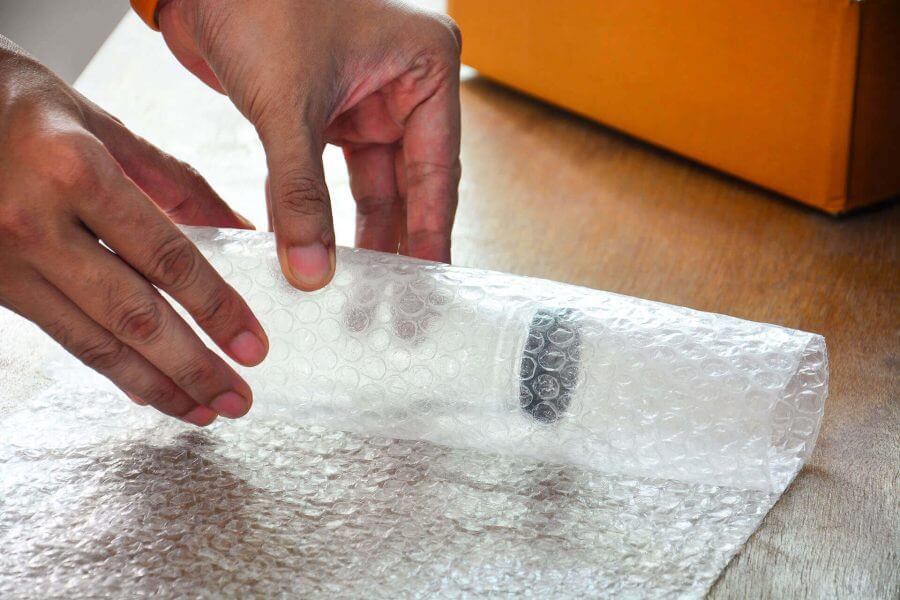

How to Tackle a Small Long-Distance Move Successfully
Posted in How-to,Moving Essentials,Moving Tips & Tricks on November 28, 2023
Embarking on a small long-distance move? Exciting times are on the horizon! While the task might initially sound challenging, rest assured that it can be an exhilarating journey. With just a sprinkle of planning and a dash of enthusiasm, this adventure will be one for the books. Dive in with us as we navigate the playful twists and turns, ensuring a seamless relocation experience.
So, what do you need to know about preparing for a small move across country? When preparing for small long-distance moves, it’s essential to prioritize. Start by decluttering, only taking items that hold significant value or purpose. Then, make a checklist to stay organized. Research and choose reputable long-distance movers who specialize in smaller relocations to ensure safety and efficiency. Packing appropriately, labeling boxes with care, and considering insurance options are also crucial steps. With thoughtful planning, the transition can be smooth and stress-free.
What Makes a Small Long-Distance Move Unique?
For starters, it’s not about transporting a vast volume of belongings but about the strategic selection of relocation essentials. This focused approach brings both challenges and advantages.
The challenges lie in deciding what’s truly essential and ensuring these items are transported safely. The upside? A potentially tighter relocation budget due to reduced costs. Plus, by focusing on essentials, one can streamline the process, making settling into a new place swifter and more efficient.
How to Prioritize Belongings For A Small Relocation?
When it comes to a small relocation, prioritizing belongings becomes a pivotal task. Start by reviewing all possessions to narrow down the home inventory list. Not everything you own needs to make the cross-country journey. Consider hosting a garage sale, which not only helps declutter but also adds a little extra to the moving budget.
For items that don’t sell, donate them to local shelters or charities such as Goodwill and The Salvation Army. By doing so, you’re not just lightening the load but also making a positive impact on the community.
What Costs Should Be Considered?
When planning a small long-distance move, it’s crucial to factor in various costs to ensure you’re not caught off guard. While aiming to save money, here’s a list of expenses that might be encountered:
- Transportation fees – Charges from moving companies or rental truck costs.
- Packing materials – Boxes, bubble wrap, and packing tape.
- Accommodation and travel – Take into account expenses for traveling to the new destination.
- Unforeseen expenses – Things like road tolls or last-minute packing supplies.
Figure Out Logistics of Long-Distance Small Move
Diving into the logistics is an essential step to ensure a smooth transition. To prepare for moving day, create a detailed plan outlining every stage of the transition. It helps in foreseeing any potential hiccups.
Before sealing the deal with any moving company, have a comprehensive list of questions to ask movers. This ensures clarity on their responsibilities, the costs involved, and the services they offer. Being well-informed means being well-prepared, setting the stage for a successful relocation.

Pre-Move Planning Checklist
Before diving into the intricacies of relocating to a new city, a well-thought-out pre-move plan can set the stage for a seamless transition. Here’s a checklist to guide you through some essential steps:
- Research the destination – Familiarize yourself with the new city’s culture, amenities, and neighborhoods.
- Notify important parties – Inform the bank, post office, and other relevant entities about your plans.
- Secure important documents – Ensure passports, licenses, and other vital documents are easily accessible.
- Plan for pets – If you have animals, consider their needs during the whole process.
- Hire professionals or DIY – Decide if you’re hiring movers or doing it yourself.
How to Assess the Inventory and Plan the Budget?
Before shelling out money on cross-country moving services, it’s paramount to assess the inventory. This helps in understanding the volume and nature of items to be moved, which in turn shapes the budget.
Start by categorizing belongings based on necessity, sentiment, and utility. Items that haven’t been used in a year are prime candidates for selling or donating. Once you’ve narrowed down the essentials, get estimates from multiple movers to ensure you get the best deal and services for your budget.
Here is a helpful video for downsizing before a small long-distance relocation.
Consider the Time Frame of the Relocation
The time frame can significantly influence relocation stress. A rushed relocation can lead to overlooked details and added anxiety, while an extended timeline might result in procrastination. It’s all about striking the right balance.
Determine key dates such as when to start packing, the moving day itself, and when to arrive at the new location. Schedule some buffer time for unexpected delays. By managing the timeline effectively, make sure to mitigate stress and ensure a smooth relocation journey.

Hire a Reputable Cross-Country Moving Company
The importance of engaging a trustworthy cross-country moving company cannot be overstated, particularly in light of recent statistics. In 2023, a concerning 12% increase in moving scam reports was registered with the Better Business Bureau compared to the previous year. The financial repercussions of these scams are anticipated to escalate to $1.59 million, marking a whopping 42% jump from last year’s figures.
These figures emphasize the critical nature of due diligence in the moving across country process. It’s essential to meticulously research potential companies, sift through reviews, validate their credentials, and seek referrals. This not only safeguards your belongings but also ensures you aren’t part of a growing number of individuals financially impacted by scams.
Select the Right Moving Service
When moving small loads across country, the plethora of service options available can seem overwhelming. It’s not just about getting from Point A to Point B, but how you want to do it. For some, using only relocation services is enough for the amount of belongings owned.
Others may require more comprehensive assistance, such as partial or full packing services. Furthermore, if you’re relocating a vehicle, auto transport services become a vital consideration. Deciding on which services to invest in comes down to assessing personal needs, budget constraints, and the time one can dedicate to the process.

Packing Smart for a Small Move
The key to successful small moves long distance is an efficient strategy. A small-scale transition doesn’t necessarily mean it’s easier; in fact, efficient packing becomes even more crucial. With limited items, every piece counts, and you want to ensure that each item is securely packed.
It’s about making smart decisions – prioritize essentials, declutter to reduce unnecessary volume, and always think about the utility of each item in the new destination. Remember, with a smaller relocation, you have the advantage of being more meticulous, ensuring that only the most vital belongings make the journey.
What Essential Packing Supplies Are Needed?
Having the right packing materials on hand is indispensable. Here’s a list of essentials:
- Sturdy boxes of various sizes ensure they can hold the weight of their contents.
- Bubble wrap is ideal for wrapping fragile items and providing cushioning.
- Packing tape securely seals all boxes.
- Labeling markers for clear identification of box contents.
- Packing paper is useful for wrapping items and filling empty spaces in boxes.
- Stretch wrap for bundling items together or protecting furniture.
Our Tips for Packing Fragile Items
The easiest way to pack for relocation, especially when it involves fragile items, is to embrace patience and precision. Begin by selecting sturdy boxes that are appropriately sized – not too large that items shift, but not so small that they’re crammed. Layer the bottom with crumpled packing paper or bubble wrap for added cushioning.
Wrap each fragile item individually, using bubble wrap or packing paper. Place heavier items at the bottom and lighter ones on top. Fill any voids with crumpled paper to prevent movement, and always label the box as “Fragile” prominently.

Do You Need to Relocate Specialty Items? Here’s How to Do It
It’s not just about wrapping specialty items in bubble wrap and hoping for the best. Instead, the process entails several key stages – initial assessment, where you identify the items and evaluate their specific needs; specialized packing, using materials tailored to protect the particular item; securing reliable transportation that can handle the delicacies involved; and finally, ensuring that appropriate insurance coverage is obtained to safeguard against potential damages.
Preparing Antiques and Valuables
When the time comes to pack paintings, artwork, and antiques, it’s paramount to exercise extra caution. These items often carry both monetary and sentimental value, making their safe transition crucial. Begin by assessing each piece to determine its vulnerability. Fragile parts, like the frames of paintings or delicate ceramic antiques, need reinforced protection.
Use acid-free paper for artwork to prevent discoloration. Bubble wrap and soft blankets can offer added layers of protection. If in doubt, consult cross-country movers and consider custom crating solutions for exceptionally valuable pieces that can be beneficial.
Considerations For Electronic Devices
For large TVs, gaming gadgets, and stereo speakers, start by referring to original manuals (or online guides) for disassembly instructions. Use original packaging if available, as they’re often designed for safe transportation.
If original boxes aren’t accessible, secure screens with foam or screen protectors and place them in boxes with ample padding. For speakers and theater systems, detach any removable parts and pack them separately, ensuring wires and cables are organized and labeled.

How to Navigate the Moving Day?
The day has arrived – it’s time to move! Staying organized and having a clear plan can alleviate much of the stress. Start by waking up early, ensuring you have a hearty breakfast to fuel you through the day. Dress comfortably, in layers if the weather is unpredictable, and wear sturdy shoes. Be on hand to oversee and guide the movers, communicate any specific needs or concerns, and make sure all belongings are accounted for before the truck departs.
Go Through the Final Checklist
Before the relocation truck hits the road, it’s essential to go through the final checklist. This ensures that no item or task has been overlooked. Starting a few days before the relocation day, compile a comprehensive list of tasks and items. This could include turning off utilities, ensuring fragile items are packed safely, or even checking the storage areas one last time. On the day, methodically tick off each item on the final checklist.
How to Deal With Movers
Building a good rapport with the long-distance movers can make the process smoother. If you’re moving in summer, offering cold beverages can be a kind gesture, while a hot drink is welcome when relocating in winter.
Clear any pathways of snow or debris to ensure their safety. Always communicate clearly about any specific instructions or concerns. At the end of the relocation, if you’re satisfied with the service, consider tipping movers.
Prepare an Emergency Kit
Everyone should have an accompanying emergency kit. This kit should include essential documents (like IDs, passports, and lease agreements), a change of clothes, medications, basic toiletries, snacks, bottled water, and some cash. It’s also wise to have a flashlight, a small first-aid kit, and chargers for the devices. Having these essentials on hand ensures you’re prepared for any unforeseen hiccups.
Finally, Settle In Your New Place
Transitioning into a new home is more than just unpacking; it’s about creating a space where you feel at peace. Start by deep cleaning the rooms before arranging furniture – it’s easier and ensures a fresh beginning.
Prioritize unpacking essential rooms like the bedroom and kitchen first. Introduce yourself to neighbors since a friendly hello can pave the way for lasting community bonds. Familiarize yourself with local amenities, from grocery stores to parks, to make daily living more convenient. Remember, it’s okay to feel a mix of emotions.
Consider Hiring Our Cross-Country Movers to Make the Transition Effortless
With the right support, a small-long-distance move can be streamlined and stress-free. This is where we, Cross-Country Movers, come in. Our expert team is equipped with the skills and experience to manage every facet of the relocation. Ensure you have everything needed for an effortless transition to the new destination. As you’ve learned from our comprehensive guide, preparation is key. But with us by your side, gain the peace of mind that every step is in capable hands. So, when pondering your next relocation, consider making it an easy one. Contact Cross Country Movers, and let’s embark on this journey together.
FAQ
Can I Get a Discount for a Small Long-Distance Move?
Discounts vary by moving company for moving small loads long distance, but many offer special rates or promotions for smaller moves. It’s best to inquire directly with the company about available discounts.
How Far in Advance Should I Start Planning?
Ideally, start planning the whole process 2-3 months in advance to ensure a smooth transition and to secure desired dates with movers.
What Items Should I Definitely Not Bring?
Avoid moving perishables, hazardous materials, and items prohibited by movers. Also, consider decluttering items you haven’t used in over a year.
How Do I Keep My Relocation Costs Down?
To minimize relocation costs, declutter before the transition, compare multiple moving quotes, and consider moving during off-peak seasons.
What Should I Look For in a Long-Distance Moving Company?
Seek a company with positive reviews, proper licensing, transparent pricing, and experience in handling small long-distance moves.
What Is the Fastest Way to Unpack After a Small Long-Distance Relocation?
Prioritize unpacking essential rooms first, like the bedroom and kitchen, and set daily unpacking goals to maintain momentum.








